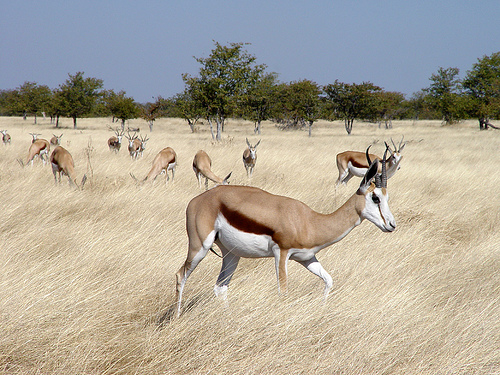Springboks are the liveliest antelope in town.
- Springboks are a type of antelope of medium stature, native to southwest Africa, and they live in dry savannah areas.
- The scientific name of springboks is Antidorcas marsupialis and it is from the Antilopinae subfamily, which is part of the Bovidae family, the family of cloven-hoofed mammals.
- Springboks generally have a red-brown, tan or brown coloured back with a white underside and face, with the addition of distinct markings, although sometimes they can be mostly dark brown or white in colour.
- Springboks range from 70 to 90 (27.5 to 35 inches) in height, excluding the neck and head, and weigh roughly 30 to 48 kilograms (66 to 106 pounds), and both adult males and females have horns.
- As one of Africa’s most abundant antelope, the estimated population of springboks in southern Africa is up to 2.5 million, and as such, they are listed as ‘least concern’.
Springbok
Image courtesy of Damien du Toit/Flickr
- The diet of springbok consists primarily of grasses, but also bushes and shrubs, which may also serve as its only water source.
- Springboks generally live in small to large herds, depending on the season, of both male and female sexes, although entirely male and entirely female herds exist.
- Springboks are notable for leaping vertically upright when scared or excited, known as ‘stotting’ or ‘pronking’, and a number of theories exist as to why this happens.
- Typically a female springbok will have one young at a time, although twins occur on rare occasions, and the mammal can live to be around 10 years of age.
- Due to a well thriving population and their natural beauty, springboks are popularly hunted for their skin and meat, or as a sport.
Bibliography:
The Springbok (Antidorcus marsupialis), 2014, SA Venues, http://www.sa-venues.com/wildlife/wildlife_springbok.htm
Springbok, 2015, Wikipedia, https://en.wikipedia.org/wiki/Springbok
Springbok, n.d, Wildscreen Arkive, http://www.arkive.org/springbok/antidorcas-marsupialis/






